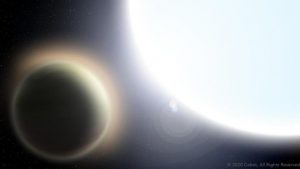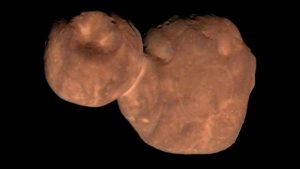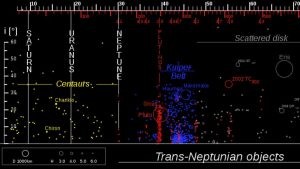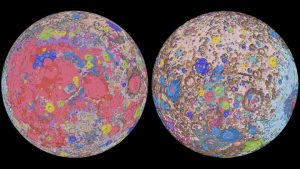
Yale’s Extreme PREcision Spectrometer (EXPRES) is giving a closer look at the atmosphere of a distant planet, a model developed at the Faculty of Physics at the Technion, in collaboration with German scientists at Tübingen, explains the unique properties of Arrokoth – the most distant object ever imaged in the solar system, a new study has identified the first known permanent population of asteroids originating from outside our Solar System, and for the first time, the entire lunar surface has been completely mapped and uniformly classified by scientists from the USGS Astrogeology Science Center.
Links
Yale technology is giving astronomers a closer look at the atmosphere of a distant planet where it’s so hot the air contains vaporized metals
A model developed at the Technion explains the unique characteristics of “the Snowman,” known formally as Arrokoth
A new study has identified the first known permanent population of asteroids originating from outside our Solar System.
- Interstellar asteroids found hiding in plain sight (RAS.ac.uk)
- New discovery: first asteroid population from outside our solar system (CNRS)
For the first time, the entire lunar surface has been completely mapped and uniformly classified by scientists from the USGS Astrogeology Science Center, in collaboration with NASA and the Lunar Planetary Institute
Transcript
This is the Daily Space for today, Friday, April 24, 2020. I am your host Dr. Pamela Gay, and I am here to put science in your brain.
Here on Earth, we often take our climate for granted. We complain when it’s too hot. We complain when it’s too cold. We get grouchy when winter lasts too long, and we get concerned for our fruit trees when spring comes too early. Humans are picky, and we don’t always know just how lucky we’ve got it.

For instance, take a look at the planet Kelt 20-b, a hot Jupiter located 450 ly away and orbiting a hot A type star. This world orbits every 3.5 days at a distance just 5% the Earth’s distance from the sun. This charbroiled planet was recently studied by Yale’s Extreme PREcision Spectrometer (EXPRES), and scientists were able to study the planet’s atmosphere as it went from beside its host star to directly in front. KELT-20’s light passed through its planet’s atmosphere, some of that light was absorbed out, and the exact colors of those dark bands of absorption tell us what chemicals are present. Thanks to the light gathering power and resolution of the 4.3 m Lowell Discovery that was used, they could actually see gaseous iron, magnesium, and chromium. They also noted differences between the dawn and dusk sides of the world. These differences will allow collaboration scientists to create atmospheric circulation models. These are still early days for both this discovery and this instrument, which are described in a new publication in Astronomy & Astrophysics that was led by Jens Hoeijmakers.

As computers get more powerful, astronomers and planetary scientists are piece by piece trying to take this amazing wealth of data we have and build a coherent understanding of how all the crazy things we find could come into being. One of the more recent points of struggle has been the Kuiper Belt object Arrokoth. This bilobate object had to form through a slow motion collision, and while we have been able to wave our hands and say “These are the requirements.” This is like tasting a meal and being able to taste all the ingredients. It’s a start, but throwing all those ingredients into a bowl and staring at them won’t make you a meal. There is the “how did this happen” that is also needed. Now, a group of computational modelers from the Technion Society have published in Nature results on a model that looks at the two lobes of Arrokoth as separate bodies orbiting the Sun. Including the Sun makes this a 3 body problem that has to be numerically stepped through, analyzing how all the forces play out over time. This careful approach allowed them to see how the two objects could gravitationally catch each other and tumble in a circular path around a gravitational center of their 2 masses while orbiting the Sun. This isn’t stable, and over time, the orbit would evolve, going elliptical, and then spiraling the object in to gently merge. It is a beautiful numerical dance, and I’m sad to report they didn’t share a video of their model. Nonetheless, we now know in numbers how Arrokoth could come to be.

This kind of “take the constraints and model the how” approach is getting used in lots of different places. One of my favorite new results comes from a team lead by Fathi Namouni at the Observatoire de la Côte d’Azur. In this case, rather than modelling a single object, this team modeled a group of objects and asked how they got there. In our outer solar system, we regularly see things in weird orbits, and when we see weird orbits that are somewhat similar, we give that class of objects in those orbits a name. One of these groups is the Centaurs, objects in orbits haphazardly scattered around the orbits of Saturn, Uranus, and inside Neptune’s orbit. Some of these objects are Icy Kuiper Belt and maybe Oort cloud objects that can have been flung in through three body interactions, and will eventually become short period comets. Others are rocky and harder to sort since our solar system’s rocky objects formed in the inner bits of the solar system. Well, it gets a lot easier to explain them if we look outside our system. A new paper in the Monthly Notices of the Royal Astronomical Society describes how at least 19 of these asteroids are of interstellar origins. Quite likely, these rocky bodies were purloined from nearby stars when our solar system was still forming, and they’ve been with us ever since. Once again we’re reminded, we are a mix of locally grown and imported worlds. Our solar system has a border – the Voyagers found it and pushed through it – and anything that wants to, can cross that border and visit us at any time.

Alright, one last news item for the day. The USGS, which maps everything, not just Earth, has released a glorious new map of the moon that details out all the geologic features on the moon in colors that make no sense without a key. In this image, which you can see on DailySpace.org, it is possible to clearly see lava covered regions on the near side, and the wild splatter patterns of craters everywhere. There are features in this that I want to know more about, specifically a wild splatter all along the edge of the moon on the far side, but that doesn’t quite come around to the nearside. I’m going to try and bring on a guest to talk about what this coherent map of the moons geology can tell us. But, that’s for another day.
For, this rounds out today’s Daily Space.
<———————>
Thank you all for listening. Today’s script was written by Pamela Gay, and the Daily Space is produced by Susie Murph. The Daily Space is a product of the Planetary Science Institute, a 501(c)3 non profit dedicated to exploring our Solar System and beyond. We are here thanks to the generous contributions of people like you. The best way you can support us is through Patreon.com/cosmoquestx Like us? Please share us! You never know whose life you can change by adding a daily dose of science.


 We record most shows live, on Twitch. Follow us today to get alerts when we go live.
We record most shows live, on Twitch. Follow us today to get alerts when we go live.